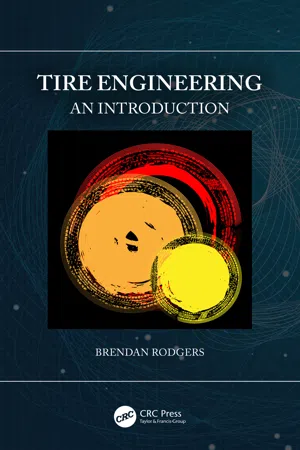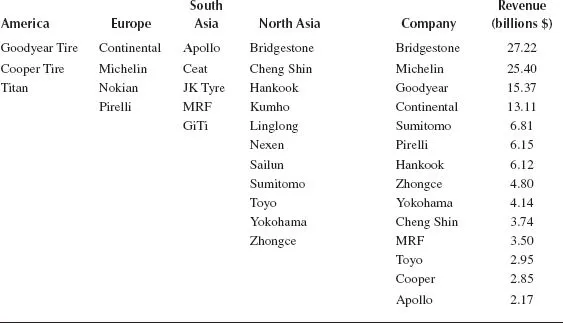
eBook - ePub
Tire Engineering
An Introduction
Brendan Rodgers
This is a test
- 278 páginas
- English
- ePUB (apto para móviles)
- Disponible en iOS y Android
eBook - ePub
Tire Engineering
An Introduction
Brendan Rodgers
Detalles del libro
Vista previa del libro
Índice
Citas
Información del libro
The modern tire is the most complex, composite product in mass production. Yet given its complexity and required performance, there is little information in the public domain regarding its development. This book provides an introduction to tire design, construction, and manufacturing in the context of materials technologies used today, along with future trends and disrupting technologies.
-
- Focuses on design and construction
-
- Discusses the relationship between materials and performance
-
- Reviews tire uniformity as a key differentiator among manufacturers
-
- Evaluates design and construction features versus performance
Written for engineers in the polymer, industrial, chemical, mechanical, and automotive industries, this book offers a comprehensive view of tire design, including materials selection, construction, manufacturing, quality control, and future trends.
Preguntas frecuentes
¿Cómo cancelo mi suscripción?
¿Cómo descargo los libros?
Por el momento, todos nuestros libros ePub adaptables a dispositivos móviles se pueden descargar a través de la aplicación. La mayor parte de nuestros PDF también se puede descargar y ya estamos trabajando para que el resto también sea descargable. Obtén más información aquí.
¿En qué se diferencian los planes de precios?
Ambos planes te permiten acceder por completo a la biblioteca y a todas las funciones de Perlego. Las únicas diferencias son el precio y el período de suscripción: con el plan anual ahorrarás en torno a un 30 % en comparación con 12 meses de un plan mensual.
¿Qué es Perlego?
Somos un servicio de suscripción de libros de texto en línea que te permite acceder a toda una biblioteca en línea por menos de lo que cuesta un libro al mes. Con más de un millón de libros sobre más de 1000 categorías, ¡tenemos todo lo que necesitas! Obtén más información aquí.
¿Perlego ofrece la función de texto a voz?
Busca el símbolo de lectura en voz alta en tu próximo libro para ver si puedes escucharlo. La herramienta de lectura en voz alta lee el texto en voz alta por ti, resaltando el texto a medida que se lee. Puedes pausarla, acelerarla y ralentizarla. Obtén más información aquí.
¿Es Tire Engineering un PDF/ePUB en línea?
Sí, puedes acceder a Tire Engineering de Brendan Rodgers en formato PDF o ePUB, así como a otros libros populares de Tecnologia e ingegneria y Trasporti e ingegneria automobilistica. Tenemos más de un millón de libros disponibles en nuestro catálogo para que explores.
Información
1 Introduction to Tire Engineering
1.1 Introduction to the Global Tire Industry
The global tire industry has shown remarkable growth, reflecting the growing global economy and the corresponding increase in standards of living. Discounting the impact of the pandemic due to COVID-19, in the year 2020, total global tire production had been expected to exceed three billion units. Though there is considerable variation in researcher’s estimates for both previous and future production, regardless of the source, the growth of the tire industry has been largely linear over time, with an anticipated minor dip in 2021 and 2022, and then a return to historic linear growth rates from 2023 onwards (1–3). Other than a dip in 2009, the raw materials supply base for the industry has shown similar growth rates and is expected to exceed $110 billion by 2024, illustrating the impact of the industry on global economic growth (4).
Geographically, most of the future industry growth will be in East and South-East Asia, and will be driven by a number of important factors, first of which is a strong desire for car ownership, despite car sharing and other inner-city demographic trends. Secondly, increasing transportation growth and efficiency will continue to drive the trucking industry and associated truck and bus tire demands. Thirdly, national economic policies will influence future investments in new capacity. Tire manufacturing is labor intensive, capital intensive, and requires a high level of skilled labor, thereby supporting governmental policies on employment. This point will be reviewed in Chapter 8, on tire manufacturing.
With regard to industry growth estimates, there is typically a high degree of variability in the industry reports (5, 6, ). This is due to many factors, such as the quality of the raw data being collected, what tires to include, and the proprietary nature of data tire companies are willing to release. This discussion on tire engineering and technology will focus on only the main line tires, which cover products for the consumer and commercial markets, i.e., racing, passenger car, light truck, commercial truck and bus, farm, heavy-duty off-road, and aircraft tires. Though much of the technology still applies, bicycle, motorcycle, and light utility applications are largely excluded (Figure 1.1).

Within the industry, there have been two core business trends, firstly, the merging or acquisition of manufacturing companies in North America and Europe, driven by the need for economy of scale, and secondly, the emergence of new companies in Asia. In China, the government has encouraged the merging of companies to achieve economy of scale, to improve quality, and to protect employment. For example, tire factories require a certain throughput rate to be economic, in the order of 20,000 to 25,000 passenger tires per day or 270 tons of products, depending on the tire types. The merging of smaller companies helps to facilitate more economic manufacturing output rates. Otherwise, manufacturing costs can undergo a rapid exponential increase as output drops, which has been one of the underlying reasons for the closing of many plants in traditional markets. Furthermore, the global market has evolved into essentially four regions, defined by the level of economic development and the quality of the transportation infrastructure. This is reflected in the number of tire manufacturing companies and the location of their headquarters (Table 1.1).
TABLE 1.1
Global Tire Manufacturing Participation and Revenues (7, 8, )
Global Tire Manufacturing Participation and Revenues (7, 8, )

The emergence of four distinct regions or markets is driven by consumer requirements, infrastructure, and the local or national regulatory environments. What is common between the regions is a similar manufacturing base, i.e., the same type of production equipment and the same global raw materials supply base. The differences are with respect to product design, construction, and the compound line-up of the materials to meet the market needs. Table 1.2 is a simplified snapshot of regional performance parameters that regulators and consumers consider in tire performance. Though parameters such as traction and vehicle stopping distances are important in all markets, some performance parameters will tend to receive more emphasis than others, depending on the market.
TABLE 1.2
Tire Demographic Trends and General Focus for Different Regions (5)
Tire Demographic Trends and General Focus for Different Regions (5)

Given the nature of the various markets, there are still many factors in tire technology in common, which are applicable to all markets, and this will now be covered. Five aspects of tire engineering and technology will be discussed: tire design, construction, materials technology, manufacturing, and end-product performance. There are many subsets to each of these five core areas. For example, in manufacturing, quality control and tire uniformity are of the utmost importance. Each tire manufacturer will have its proprietary procedures and processes to meet their product design requirements. This review will therefor...